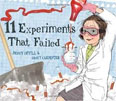 
|
The unique picture book 11 Experiments That Failed is a very fun book about an adventurous girl who conducts 11 “science” experiments. Each experiment follows the same format: Question, Hypothesis, What You Need, What to Do and What Happened. There are experiments with food, animals, motion, perfume, and household objects. is a very fun book about an adventurous girl who conducts 11 “science” experiments. Each experiment follows the same format: Question, Hypothesis, What You Need, What to Do and What Happened. There are experiments with food, animals, motion, perfume, and household objects.
All the experiments are plausible, at least in a child’s mind. For example: Can a kid make it through the winter eating only snow and ketchup? Would gerbils like bigger wheels? What’s the best way to speed up a boring car ride? All are extremely humorous and pretty naughty—no one should try these at home.
The book begins with some clever endpapers, drawings on wrinkled graph paper of a Rube Goldberg-like contraption which delivers bologna to the girl’s bread. She tosses that one aside and begins the first experiment at the table, dressed in a lab coat and safety goggles.
The text is written mostly in phrases, rather than sentences, and works in complete harmony with the pictures. The illustrations are mostly colored line drawings, with a few photographs within each drawing. For example, real grilled cheese on a stinky sneaker—answers the question what makes fungus grow?
Similar in humor and fun to Jenny Offill and Nancy Carpenter’s 17 Things I’m Not Allowed to Do Anymore! , this book is very amusing to read aloud. The consistent format is actually a perfect introduction—or better yet, a follow-up to a serious discussion of the scientific process. After reading this book children will have a basic understanding of what a hypothesis is and how it can be tested.
There is so much detail and humor in the illustrations, coupled with the brief, carefully chosen text. Adults and children will want to read it again and again.
|







|